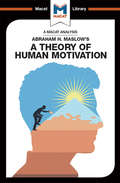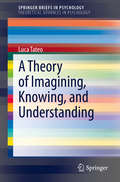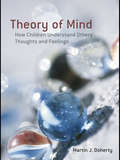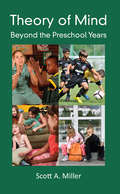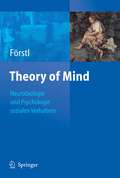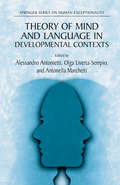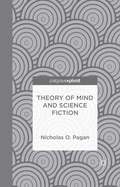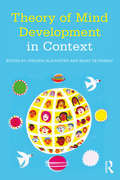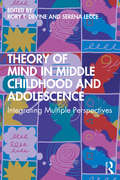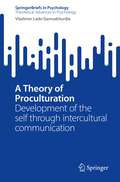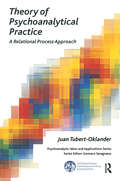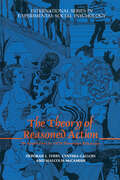- Table View
- List View
Theory of Human Action
by Alvin I. GoldmanThis book articulates an original scheme for the conceptualization of action. Beginning with a new approach to the individuation of acts, it delineates the relationships between basic and non-basic acts and uses these relationships in the definition of ability and intentional action. The author exhibits the central role of wants and beliefs in the causation of acts and in the analysis of the concept of action.Professor Goldman suggests answers to fundamental questions about acts, and develops a set of ideas and principles that can be used in the philosophy of mind, the philosophy of language, ethics, and other fields, including the behavioral sciences.Originally published in 1977.The Princeton Legacy Library uses the latest print-on-demand technology to again make available previously out-of-print books from the distinguished backlist of Princeton University Press. These editions preserve the original texts of these important books while presenting them in durable paperback and hardcover editions. The goal of the Princeton Legacy Library is to vastly increase access to the rich scholarly heritage found in the thousands of books published by Princeton University Press since its founding in 1905.
A Theory of Human Motivation (The Macat Library)
by Stoyan StoyanovUS psychologist Abraham Maslow’s A Theory of Human Motivation is a classic of psychological research that helped change the field for good. Like many field-changing thinkers, Maslow was not just a talented researcher, he was also a creative thinker – able to see things from a new perspective and show them in a different light. At a time when psychology was dominated by two major schools of thought, Maslow was able to forge a new, third paradigm, that remains influential today. Sigmund Freud’s psychoanalysis had developed the idea of understanding the mind through dialogue between patient and analyst. The behaviorism of Ivan Pavlov and John Watson had focused on comprehending the mind through behaviors that could be measured, trained, and changed. Maslow, however, generated new ideas, forging what he called “positive” or “humanistic psychology”. His argument was that humans are psychologically motivated by a series of hierarchical needs, starting with the most essential first. Maslow thought it important for the advancement of psychology to identify, group and rank these needs in terms of priority. His belief in the value of this third way was important in leading those who studied psychology to redefine the discipline, and so see it in new ways.
A Theory of Human Motivation (The Macat Library)
by Stoyan StoyanovUS psychologist Abraham H. Maslow’s A Theory of Human Motivation is a classic of psychological research that helped change the field for good. Like many field-changing thinkers, Maslow was not just a talented researcher, he was also a creative thinker – able to see things from a new perspective and show them in a different light. At a time when psychology was dominated by two major schools of thought, Maslow was able to forge a new, third paradigm, that remains influential today. Sigmund Freud’s psychoanalysis had developed the idea of understanding the mind through dialogue between patient and analyst. The behaviorism of Ivan Pavlov and John Watson had focused on comprehending the mind through behaviors that could be measured, trained, and changed. Maslow, however, generated new ideas, forging what he called “positive” or “humanistic psychology”. His argument was that humans are psychologically motivated by a series of hierarchical needs, starting with the most essential first. Maslow thought it important for the advancement of psychology to identify, group and rank these needs in terms of priority. His belief in the value of this third way was important in leading those who studied psychology to redefine the discipline, and so see it in new ways.
A Theory of Imagining, Knowing, and Understanding (SpringerBriefs in Psychology)
by Luca TateoThis is a book about imaginative work and its relationship with the construction of knowledge. It is fully acknowledged by epistemologists that imagination is not something opposed to rationality; it is not mere fantasy opposed to intellect. In philosophy and cognitive sciences, imagination is generally “delimiting not much more than the mental ability to interact cognitively with things that are not now present via the senses.” (Stuart, 2017, p. 11) For centuries, scholars and poets have wondered where this capability could come from, whether it is inspired by divinity or it is a peculiar feature of human mind (Tateo, 2017b). The omnipresence of imaginative work in both every day and highly specialized human activities requires a profoundly radical understanding of this phenomenon. We need to work imaginatively in order to achieve knowledge, thus imagination must be something more than a mere flight of fantasy. Considering different stories in the field of scientific endeavor, I will try to propose the idea that the imaginative process is fundamental higher mental function that concurs in our experiencing, knowing and understanding the world we are part of. This book is thus about a theoretical idea of imagining as constant part of the complex whole we call the human psyche. It is a story of human beings striving not only for knowledge and exploration but also striving for imagining possibilities.
A Theory of Individual Behavior
by Robert WichersA Theory of Individual Behavior dispels the notion that individuals act as rational agents and strives to capture idiosyncratic humanness through rigorous mathematics. Wichers describes a version of economic behavior that is more comprehensive and satisfying than neoclassical models yet still consistent with the usual aggregated concepts that form the basis of applied microeconomics. Written in an accessible and convincing style, A Theory of Individual Behavior discusses innovative material in a format that encourages classroom use. All chapters have questions at their conclusions, and there is a strong emphasis on testable results. The book contains a short review of mathematical models and discussion of received microeconomic theory, as well as summaries at the ends of chapters and many examples and illustrations.Dispels the notion that individuals act as rational agents while capturing idiosyncratic human behavior through rigorous mathematicsPresents an innovative approach to the evolution of microeconomic theoryPromotes advances in behavioral theories in the social sciences, including psychology and sociologyDelivers an accessible style with a strong emphasis on testable results
Theory of Mind: How Children Understand Others' Thoughts and Feelings (International Texts in Developmental Psychology)
by Martin DohertyMost of us are continually aware that others have thoughts and feelings – but are children? When? This book is a concise and readable review of the extensive research into children’s understanding of what other people think and feel, a central topic in developmental psychology known as "Theory of Mind". The understanding of belief is central to this text, which explains in simple terms what representational theory of mind is all about, and shows how researchers have demonstrated this understanding in 4-year-olds. The book considers what leads to this understanding, including the role of pretend play, understanding of attention and eye direction, and other precursors to representational understanding of mind. The general relevance of theory of mind is demonstrated through coverage of the development of other mental state concepts, and the relationship between understanding mental representation and other representational media. The author also carefully summarizes current research on the relationship between theory of mind and concurrent developments in executive functioning, and the understanding of language. The book closes by considering autism. A major achievement of theory of mind research is the light it has helped throw on this puzzling developmental disorder. Providing a comprehensive overview of 25 years of research into theory of mind, the book will be of great interest to both students and researchers in psychology, philosophy and the cognitive sciences.
Theory of Mind: How Children Understand Others' Thoughts and Feelings (International Texts in Developmental Psychology)
by Martin DohertyMost of us are continually aware that others have thoughts and feelings – but are children? When? This book is a concise and readable review of the extensive research into children’s understanding of what other people think and feel, a central topic in developmental psychology known as "Theory of Mind". The understanding of belief is central to this text, which explains in simple terms what representational theory of mind is all about, and shows how researchers have demonstrated this understanding in 4-year-olds. The book considers what leads to this understanding, including the role of pretend play, understanding of attention and eye direction, and other precursors to representational understanding of mind. The general relevance of theory of mind is demonstrated through coverage of the development of other mental state concepts, and the relationship between understanding mental representation and other representational media. The author also carefully summarizes current research on the relationship between theory of mind and concurrent developments in executive functioning, and the understanding of language. The book closes by considering autism. A major achievement of theory of mind research is the light it has helped throw on this puzzling developmental disorder. Providing a comprehensive overview of 25 years of research into theory of mind, the book will be of great interest to both students and researchers in psychology, philosophy and the cognitive sciences.
Theory of Mind: Neurobiologie und Psychologie sozialen Verhaltens
by Hans FörstlTheory of Mind ist die Grundlage allen sozialen und „sittlichen“ Verhaltens. Rücksicht, Respekt und Mitgefühl kann nur entwickeln, wer Interesse am anderen hat, ein Gefühl für dessen Bedürfnisse und ein differenziertes Verständnis seiner Perspektiven. Störungen der Theory of Mind führen zu erheblichen Defiziten in der sozialen Interaktion; im vorliegenden Buch werden viele Beispiele dafür genannt.Für die 2. Auflage wurden die Kapitel aktualisiert und bearbeitet. Neu in dieser Ausgabe:- Mentalizing aus soziologischer Sicht- Neuronale Grundlagen- Rehabilitation
Theory of Mind: Beyond the Preschool Years
by Scott A. MillerThis is the first book to provide a comprehensive review of the burgeoning literature on theory of mind (TOM) after the preschool years and the first to integrate this literature with other approaches to the study of social understanding. By highlighting the relationship between early and later developments, the book provides readers with a greater understanding of what we know and what we still need to know about higher-order TOM. Although the focus is on development in typical populations, development in individuals with autism and in older adults is also explored to give readers a deeper understanding of possible problems in development. Examining the later developments of TOM gives readers a greater understanding of: Developments that occur after the age of 5. Individual differences in rate of development and atypical development and the effects of those differences. The differences in rate of mastery which become more marked, and therefore more informative, with increased age. What it means to have a “good theory of mind.” The differences between first- and second- order theory of mind development in preschoolers, older children, adolescents, and adults. The range of beliefs available to children at various ages, providing a fuller picture of what is meant by “understanding of belief.” After the introduction, the literature on first-order developments during the preschool period is summarized to serve as a backdrop for understanding more advanced developments. Chapter 3 is devoted to the second-order false belief task. Chapters 4 and 5 introduce a variety of other measures for understanding higher-level forms of TOM thereby providing readers with greater insight into other cognitive and social developmental outcomes. Chapter 6 discusses the relation between children’s TOM abilities and other aspects of their development. Chapters 7 and 8 place the work in a historical context. First, the research on the development of social and mental worlds that predated the emergence of TOM is examined. Chapter 8 then provides a comparative treatment of the two literatures and how they complement one another. Ideal as a supplement in graduate or advanced undergraduate courses in theory of mind, cognitive development, or social development taught in psychology and education. Veteran researchers will also appreciate this book‘s unique synthesis of this critical research.
Theory of Mind: Beyond the Preschool Years
by Scott A. MillerThis is the first book to provide a comprehensive review of the burgeoning literature on theory of mind (TOM) after the preschool years and the first to integrate this literature with other approaches to the study of social understanding. By highlighting the relationship between early and later developments, the book provides readers with a greater understanding of what we know and what we still need to know about higher-order TOM. Although the focus is on development in typical populations, development in individuals with autism and in older adults is also explored to give readers a deeper understanding of possible problems in development. Examining the later developments of TOM gives readers a greater understanding of: Developments that occur after the age of 5. Individual differences in rate of development and atypical development and the effects of those differences. The differences in rate of mastery which become more marked, and therefore more informative, with increased age. What it means to have a “good theory of mind.” The differences between first- and second- order theory of mind development in preschoolers, older children, adolescents, and adults. The range of beliefs available to children at various ages, providing a fuller picture of what is meant by “understanding of belief.” After the introduction, the literature on first-order developments during the preschool period is summarized to serve as a backdrop for understanding more advanced developments. Chapter 3 is devoted to the second-order false belief task. Chapters 4 and 5 introduce a variety of other measures for understanding higher-level forms of TOM thereby providing readers with greater insight into other cognitive and social developmental outcomes. Chapter 6 discusses the relation between children’s TOM abilities and other aspects of their development. Chapters 7 and 8 place the work in a historical context. First, the research on the development of social and mental worlds that predated the emergence of TOM is examined. Chapter 8 then provides a comparative treatment of the two literatures and how they complement one another. Ideal as a supplement in graduate or advanced undergraduate courses in theory of mind, cognitive development, or social development taught in psychology and education. Veteran researchers will also appreciate this book‘s unique synthesis of this critical research.
Theory of Mind: Neurobiologie und Psychologie sozialen Verhaltens
Zorzi von Castelfranco (»Giorgione« oder der große Giorgio) hinterließ ein rätselhaf es Bild, das nur einen Teil seiner Spannung aus dem Gewitter im Hintergrund bezieht. Da wir uns mit Psychologie und Hirnfunktion in sozialen Beziehungen beschäf igen, haben wir diese me- orologische Marginalie auf dem Umschlag abgeschnitten. Der Betrachter interessiert sich ohnehin vorrangig für Mutter und Kind, hell im rechten Vordergrund der bukolischen La- schaf . Das Kind interessiert sich dagegen für nahe liegende Schlüsselreize und nicht für e- fernte Betrachter aus einer späteren Epoche, wohl aber die Mutter, deren aufmerksamer Blick auf uns gerichtet ist, während sie ihrem Säugling eher nebenbei die Brust gibt. Dass ein Sö- ner mit Lanze am linken Bildrand mit gefälligem Interesse, aber ohne erkennbare Beziehung zur Mutter – ähnlich wie wir – auf sie schaut, irritiert zusehends. Wie Röntgenaufnahmen des Bildes zeigen, stand vorher an gleicher Stelle eine Nymphe im Wasser. Fand Giorgione es möglicherweise reizvoller, uns – in einem kühnen Vorgrif auf die Symbolik eines Sigmund Freud – quasi auf der Leinwand zu spiegeln und unsere Intentionen zu entdecken, während die mythologische Bedeutung und die psychologische Situation innerhalb des Bilderrahmens hermetisch verschlossen bleiben? Aber derartige hermeneutische Aufgaben gehören zum Kerngeschäf unseres Gehirns, und wir sind gewohnt, zu brauchbaren Arbeitshypothesen zu gelangen. T eory of Mind (ToM) ist der Versuch, andere und ihre Absichten zu verstehen und dadurch unser eigenes Verhalten vernünf ig anzupassen.
Theory of Mind and Language in Developmental Contexts (The Springer Series on Human Exceptionality)
by Alessandro Antonietti Antonella Marchetti Olga Liverta SempioProvides new empirical study data that explores the influence of linguistic variables within developmental contexts on theory of mind development and functioning Establishes context for usage, including personal, social, and business interactions Offers a comprehensive overview on the most current studies that address the relationship between language and theory of mind
Theory of Mind and Science Fiction
by N. PaganTheory of Mind and Science Fiction shows how theory of mind provides an exciting 'new' way to think about science fiction and, conversely, how science fiction sheds light not only on theory of mind but also empathy, morality, and the nature of our humanity.
Theory of Mind and the Triad of Perspectives on Autism and Asperger Syndrome: A View from the Bridge
by Olga BogdashinaInspired by the often uncomfortable interplay between autistic individuals, parents and professionals in understanding autistic spectrum conditions, Olga Bogdashina uses the concept of Theory of Mind (ToM) to consider these groups' different (and often conflicting) perspectives.
Theory of Mind Development in Context
by Virginia Slaughter Marc De RosnayTheory of Mind Development in Context is the first book of its kind to explore how children’s environments shape their theory of mind and, in turn, their ability to interact effectively with others. Based on world-leading research, and inspired by the ground-breaking work of Candida Peterson, the original collected chapters demonstrate that children’s understanding of other people is shaped by their everyday environment. Specifically, the chapters illustrate how theory of mind development varies with broad cultural context, socioeconomic status, institutional versus home rearing, family size, parental communication style, and aspects of schooling. The volume also features research showing that, by virtue of their condition, children who are deaf or who have an autism spectrum disorder function in environments that differ from those of typical children and this in turn influences their theory of mind. Although much important research has emphasized the role of nature in theory of mind development, this book highlights that children’s understanding of other people is nurtured through their everyday experiences and interactions. This perspective is essential for students, researchers, and practitioners to gain a complete understanding of how this fundamental skill develops in humans. The book is invaluable for academic researchers and advanced students in developmental psychology, education, social psychology, cognitive psychology, and the social sciences, as well as practicing psychologists, counselors, and psychiatrists, particularly those who deal with disorders involving social and/or communicative deficits.
Theory of Mind Development in Context
by Virginia Slaughter Marc De RosnayTheory of Mind Development in Context is the first book of its kind to explore how children’s environments shape their theory of mind and, in turn, their ability to interact effectively with others. Based on world-leading research, and inspired by the ground-breaking work of Candida Peterson, the original collected chapters demonstrate that children’s understanding of other people is shaped by their everyday environment. Specifically, the chapters illustrate how theory of mind development varies with broad cultural context, socioeconomic status, institutional versus home rearing, family size, parental communication style, and aspects of schooling. The volume also features research showing that, by virtue of their condition, children who are deaf or who have an autism spectrum disorder function in environments that differ from those of typical children and this in turn influences their theory of mind. Although much important research has emphasized the role of nature in theory of mind development, this book highlights that children’s understanding of other people is nurtured through their everyday experiences and interactions. This perspective is essential for students, researchers, and practitioners to gain a complete understanding of how this fundamental skill develops in humans. The book is invaluable for academic researchers and advanced students in developmental psychology, education, social psychology, cognitive psychology, and the social sciences, as well as practicing psychologists, counselors, and psychiatrists, particularly those who deal with disorders involving social and/or communicative deficits.
Theory of Mind in Middle Childhood and Adolescence: Integrating Multiple Perspectives
by Rory T. Devine Serena LecceThis landmark text integrates diverse perspectives on how humans understand others’ minds (or ‘theory of mind’) beyond early childhood into middle childhood and adolescence. It explores how the neural, cognitive, and social changes of middle childhood and adolescence shape the ongoing development of theory of mind, and how theory of mind helps children navigate their lives. Drawing on cutting-edge research from leading international experts, this book provides a survey and analysis of the current state and future direction of the field. It is organized around three themes relating to the key issues in contemporary research. The first part focuses on the biological and cognitive bases of theory of mind in middle childhood and adolescence. The second part goes on to explore the social predictors and consequences, considering how theory of mind is shaped by social experiences and, in turn, impacts children’s social lives in middle childhood and adolescence. Finally, the third part focuses on theory of mind in the context of neurodiversity, disability, and youth mental health in middle childhood and adolescence. Offering in-depth understanding for all students and scholars of developmental and cognitive psychology, neuroscience, clinical psychology and psychiatry, and education, this valuable text also identifies an agenda for future scholarship on this exciting topic.
Theory of Mind in Middle Childhood and Adolescence: Integrating Multiple Perspectives
by Rory T. Devine and Serena LecceThis landmark text integrates diverse perspectives on how humans understand others’ minds (or ‘theory of mind’) beyond early childhood into middle childhood and adolescence. It explores how the neural, cognitive, and social changes of middle childhood and adolescence shape the ongoing development of theory of mind, and how theory of mind helps children navigate their lives. Drawing on cutting-edge research from leading international experts, this book provides a survey and analysis of the current state and future direction of the field. It is organized around three themes relating to the key issues in contemporary research. The first part focuses on the biological and cognitive bases of theory of mind in middle childhood and adolescence. The second part goes on to explore the social predictors and consequences, considering how theory of mind is shaped by social experiences and, in turn, impacts children’s social lives in middle childhood and adolescence. Finally, the third part focuses on theory of mind in the context of neurodiversity, disability, and youth mental health in middle childhood and adolescence. Offering in-depth understanding for all students and scholars of developmental and cognitive psychology, neuroscience, clinical psychology and psychiatry, and education, this valuable text also identifies an agenda for future scholarship on this exciting topic.
The theory of planned behaviour (Large Print)
by Rnib BookshareThis is a flow chart diagram and consists of five boxes and eight arrows. There is a locator dot shown, which will be at the top left of the page when the image is the right way up. It shows the factors influencing planned behaviour in labelled boxes linked by arrows, and reads generally from left to right. Some arrows go in only one direction, whereas others are multi-directional, and some arrows link boxes horizontally, whereas others link boxes vertically.
The theory of planned behaviour (UEB Contracted)
by Rnib BookshareThis is a flow chart diagram and consists of five boxes and eight arrows. There is a locator dot shown, which will be at the top left of the page when the image is the right way up. It shows the factors influencing planned behaviour in labelled boxes linked by arrows, and reads generally from left to right. Some arrows go in only one direction, whereas others are multi-directional, and some arrows link boxes horizontally, whereas others link boxes vertically.
The theory of planned behaviour (UEB Uncontracted)
by Rnib BookshareThis is a flow chart diagram and consists of five boxes and eight arrows. There is a locator dot shown, which will be at the top left of the page when the image is the right way up. It shows the factors influencing planned behaviour in labelled boxes linked by arrows, and reads generally from left to right. Some arrows go in only one direction, whereas others are multi-directional, and some arrows link boxes horizontally, whereas others link boxes vertically.
A Theory of Proculturation: Development of the self through intercultural communication (SpringerBriefs in Psychology)
by Vladimer Lado GamsakhurdiaIn each connection with new cultural contexts a new hybrid state of cultural adaptation is constructed enabling people to adjust to new conditions by creating innovative solutions for the self. This book aims to provide a brief presentation of innovative cultural psychological theory of proculturation reflecting and oriented on the understanding of semiotic and developmental dynamics of higher mental phenomena while engaging alien signs through intercultural communication. The exploration and theoretical understanding of developmental dynamics (such as self and identity construction) of people who live in immigration or multicultural, or even multi-ethnic societies, the research builds its new focus in contrasts with the acculturation theories currently present in social psychology. The theory of proculturation has been built in opposition to cross-cultural psychological theories as well as mainstream theories of acculturation research dominated by bidimensional theoretical models. Instead, this theory is constructed based on theoretical explorations which are rooted in cultural semiotics and developmental psychological paradigm on human psychology.
Theory of Psychoanalytical Practice: A Relational Process Approach (The International Psychoanalytical Association Psychoanalytic Ideas and Applications Series)
by Juan Tubert-OklanderThis book makes an original contribution to the study of the psychoanalytic process from a relational point of view, and at the same time serves as a textbook on the theory of technique. It provides a general exposition of the theory of psychoanalytic practice from a process perspective that emphasizes the analytic relationship, the dyadic nature of the psychoanalytic situation, and the impact of unconscious interaction between its two parties, and also includes the authors personal point of view and contributions on the subject.
Theory of Psychoanalytical Practice: A Relational Process Approach (The International Psychoanalytical Association Psychoanalytic Ideas and Applications Series)
by Juan Tubert-OklanderThis book makes an original contribution to the study of the psychoanalytic process from a relational point of view, and at the same time serves as a textbook on the theory of technique. It provides a general exposition of the theory of psychoanalytic practice from a process perspective that emphasizes the analytic relationship, the dyadic nature of the psychoanalytic situation, and the impact of unconscious interaction between its two parties, and also includes the authors personal point of view and contributions on the subject.
The Theory of Reasoned Action: Its application to AIDS-Preventive Behaviour (International Series in Social Psychology)
by Cynthia Gallois Malcolm McCamish Deborah J. TerryThe Theory of reasoned action explores the theory and emphirical reserach in to the factors which influence whether people engage in high-risk practices , with specific reference to AIDS education.

